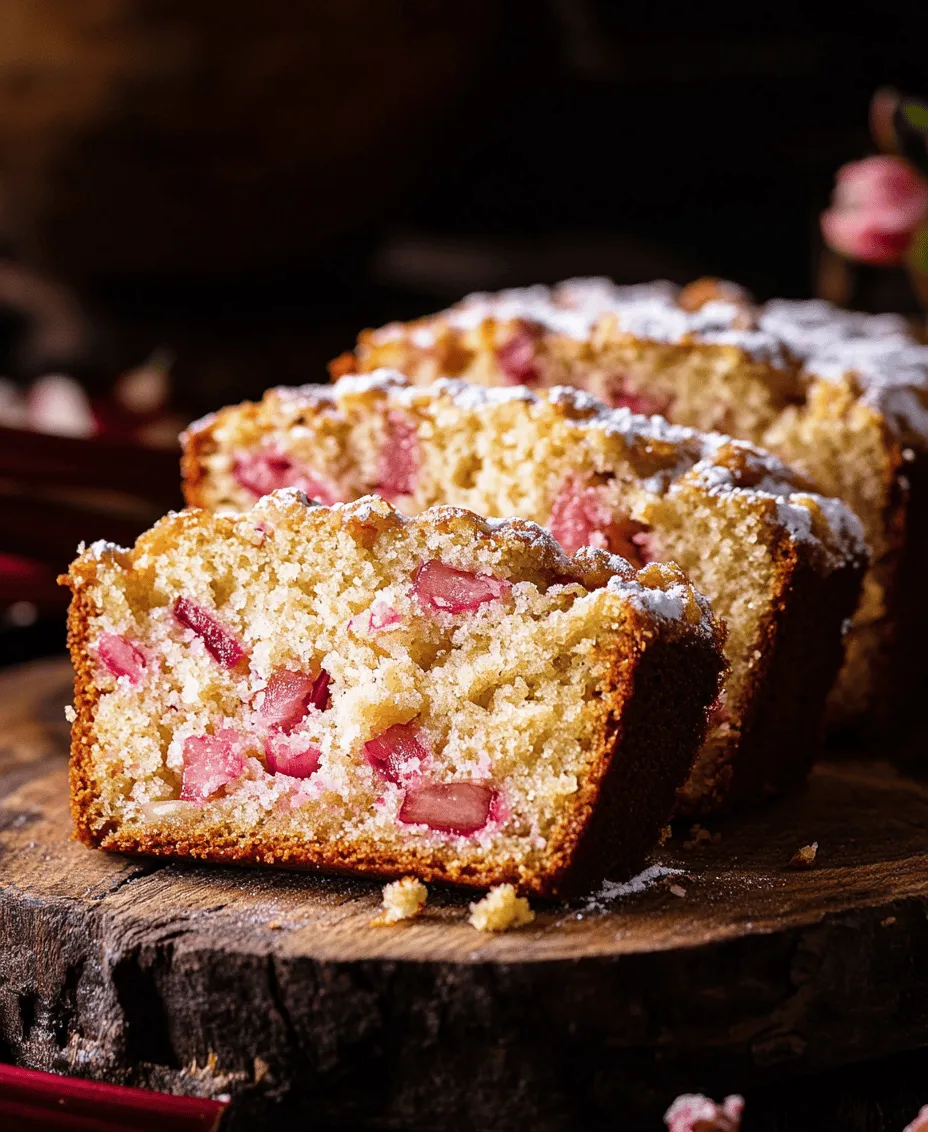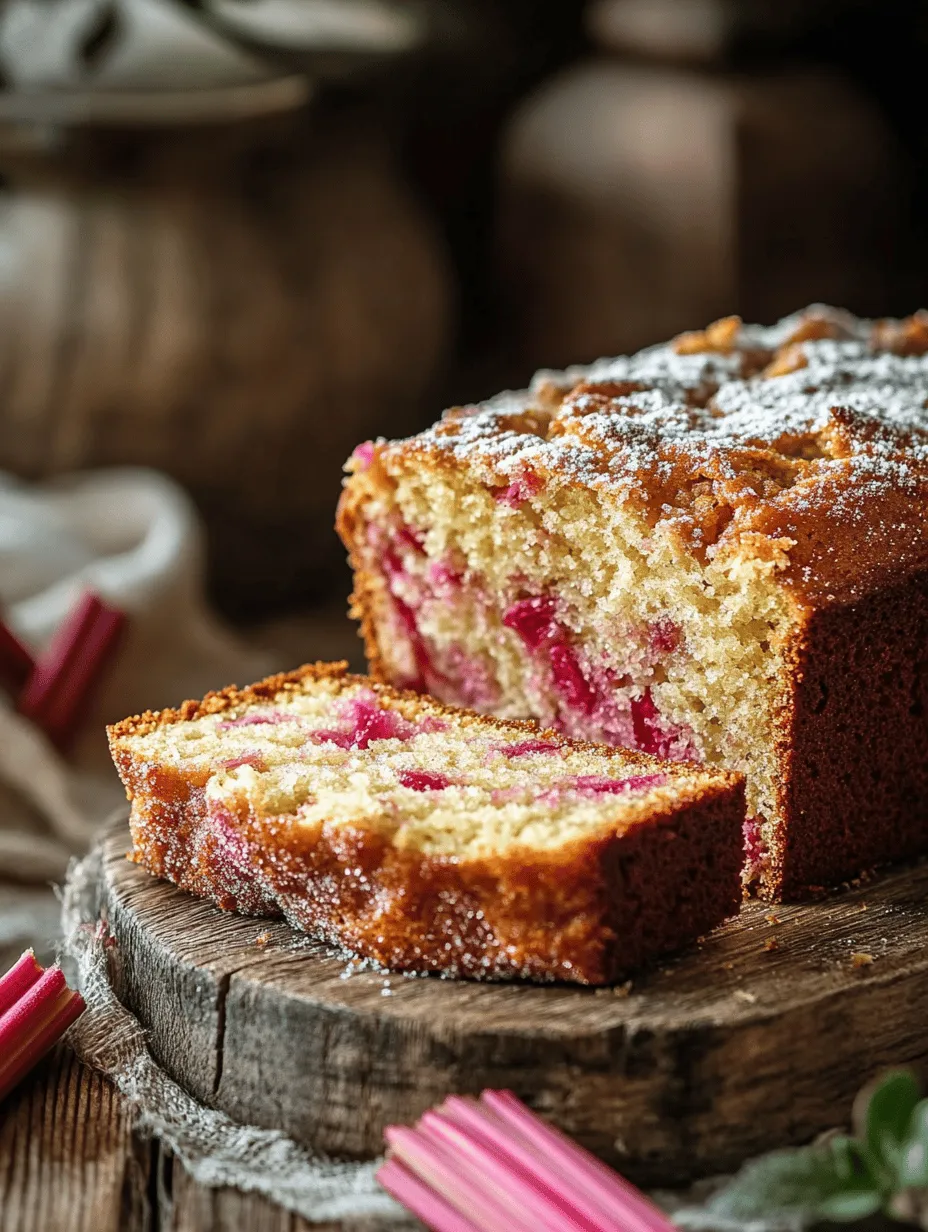Introduction: Discover the Delight of Rhubarb Bread
Rhubarb bread is a unique and delicious treat that captures the essence of spring with its vibrant flavor and moist texture. With its delightful combination of tart rhubarb, sweet undertones, and nutty hints, this loaf is not just a baked good; it’s a celebration of the season. The beauty of rhubarb bread lies in its ability to blend the bold tanginess of rhubarb with the comforting sweetness of traditional bread, creating a culinary experience that is both refreshing and satisfying.
In this article, we’ll delve into the fascinating origins of rhubarb, explore its health benefits, and provide a detailed guide for you to make your very own rhubarb bread. Get ready to impress your friends and family with a loaf that embodies the charm of springtime and showcases your baking skills.
The Allure of Rhubarb: A Brief Overview
Understanding Rhubarb: A Culinary Perspective
Rhubarb has a storied history in the culinary world, originating from ancient civilizations where it was primarily used for medicinal purposes. This perennial plant, often mistaken for a fruit due to its tart flavor, has become a staple in various cuisines, particularly in desserts and baked goods. The history of rhubarb in cooking dates back to the times of the ancient Greeks and Romans, who valued it not only for its culinary potential but also for its health benefits.
Today, there are several varieties of rhubarb, each offering a distinct flavor profile. The most common type, known as ‘Garden Rhubarb,’ is characterized by its bright red stalks, which are often used in desserts. Conversely, ‘Rhubarb Victoria’ features greenish stalks that are equally delicious. The flavor of rhubarb can range from pleasantly tart to mildly sweet, making it a versatile ingredient for both sweet and savory dishes.
Health Benefits of Rhubarb
Rhubarb is not just a delightful addition to your baking; it also packs a nutritional punch. Rich in vitamins and minerals, rhubarb is particularly high in vitamin K, which plays a key role in bone health and blood clotting. Additionally, it contains significant amounts of vitamin C, which supports the immune system and promotes healthy skin.
Beyond vitamins, rhubarb is loaded with antioxidants and dietary fiber, making it an excellent choice for those looking to improve their overall health. Antioxidants protect the body from free radicals, while dietary fiber aids in digestion and helps maintain a balanced diet. Incorporating rhubarb into your meals can contribute to heart health, support weight management, and improve digestive function.
Ingredients Breakdown: What You Need for Moist Rhubarb Bread
To create a moist and flavorful rhubarb bread, it’s essential to choose high-quality ingredients. Each component contributes to the overall taste and texture of the loaf. Below, we break down the essential ingredients you’ll need along with tips for selecting and preparing them.
Essential Ingredients
1. Fresh Rhubarb: When selecting rhubarb, look for vibrant, firm stalks with a rich color. Avoid any that appear wilted or have blemishes. To prepare the rhubarb, wash it thoroughly and trim the ends. Depending on your preference, you can chop the rhubarb into small pieces or leave it in larger chunks for more pronounced texture in the bread.
2. Granulated Sugar: Sugar is not just for sweetness; it plays a vital role in the moisture content of the bread. The sugar helps to create a tender crumb and balances the tartness of the rhubarb. You can adjust the amount based on your taste preference, but keep in mind that reducing sugar may affect the bread’s moisture.
3. Butter: For the best results, use unsalted butter. This allows you to control the salt content in your recipe. Butter adds richness and flavor to the bread, and its fat content contributes to a moist texture. Make sure your butter is softened to room temperature for easy mixing.
4. Eggs and Greek Yogurt: Eggs act as both a binder and a leavening agent, helping the bread rise while providing moisture. Greek yogurt adds richness and tang, enhancing the overall flavor and texture of the bread. Using full-fat Greek yogurt will yield the best results.
5. Baking Agents: Baking soda and baking powder are essential for achieving the right rise and texture in your bread. Baking soda reacts with the acidity in the rhubarb, while baking powder provides an additional lift. Make sure both are fresh for optimal results.
6. Flour and Spices: All-purpose flour is the base of your bread, providing structure and texture. Adding spices, such as cinnamon or nutmeg, can elevate the flavor profile and complement the tartness of the rhubarb beautifully.
7. Optional Nuts: Chopped nuts like walnuts or pecans can enhance both flavor and nutrition. They add a delightful crunch and richness that pairs well with the soft bread and tart rhubarb. If you choose to add nuts, ensure they are toasted for extra flavor.
Step-by-Step Guide to Making Rhubarb Bread
Now that you have all the ingredients ready, it’s time to get baking. Follow this step-by-step guide to create your own moist rhubarb bread.
Preheat the Oven: Setting the Stage for Baking
Before you begin mixing your ingredients, preheat your oven to 350°F (175°C). Preheating is a crucial step in baking, as it ensures that your bread will rise properly and cook evenly. While the oven is heating, prepare your loaf pan by greasing and dusting it with flour. This will prevent the bread from sticking and allow for easy removal once it’s baked.
Preparing the Rhubarb: Enhancing Flavor and Texture
To maximize the flavor of the rhubarb, toss the chopped pieces with a tablespoon of granulated sugar in a bowl. This process will help draw out moisture and enhance the natural sweetness of the rhubarb. Let the mixture sit for about 10-15 minutes. This resting period is crucial, as it allows the rhubarb to soften and release its juices, which will contribute to the overall moistness of the bread.
Creaming Butter and Sugar: The Foundation of Moistness
In a separate mixing bowl, combine the softened unsalted butter and the remaining granulated sugar. Using an electric mixer, cream the butter and sugar together until the mixture is light and fluffy. This step is essential, as it incorporates air into the batter, resulting in a lighter texture. Aim for a pale yellow color and a texture that resembles whipped cream.
Once the butter and sugar are well combined, add in the eggs, one at a time, mixing thoroughly after each addition. Follow this by adding the Greek yogurt, ensuring that everything is well blended. The combination of butter, eggs, and yogurt will provide the necessary moisture and richness that will make your rhubarb bread incredibly delicious.
By following these initial steps, you are well on your way to creating a delightful loaf of rhubarb bread that will not only satisfy your taste buds but also impress anyone lucky enough to enjoy a slice. Stay tuned for the next part of the recipe, where we will delve deeper into the mixing and baking process, ensuring your bread turns out perfectly every time.

The Science Behind Creaming Ingredients
Creaming ingredients is a crucial step in many baking recipes, including our delightful rhubarb bread. This technique involves beating together butter and sugar until the mixture is light and fluffy. The science behind this method lies in the incorporation of air into the batter, which helps to create a light and tender texture in the final product.
Incorporating Eggs and Yogurt: Building the Batter
The Function of Eggs in Baking
Eggs serve multiple purposes in baking. They act as a binding agent, helping to hold the batter together. Additionally, eggs contribute to the leavening process due to the steam they produce while cooking, which helps the bread rise. They also add richness and moisture, enhancing both the flavor and texture of the rhubarb bread. In our recipe, the eggs will be added after the butter and sugar have been creamed, ensuring that they are evenly incorporated into the batter.
Benefits of Greek Yogurt as a Moistening Agent
Greek yogurt is a wonderful addition to this recipe, bringing not only moisture but also a subtle tang that complements the tartness of the rhubarb. Its creamy texture helps to create a tender crumb while also providing additional protein. The acidity of the yogurt interacts with the baking soda, contributing to the bread’s lift and overall structure. When incorporating Greek yogurt, it’s important to use a full-fat variety for the best results, ensuring that your rhubarb bread remains moist and flavorful.
Combining Dry Ingredients: The Art of Baking
Properly Measuring Ingredients for Accuracy
Accurate measurement of dry ingredients is essential for achieving the perfect balance in your rhubarb bread. Too much flour can lead to a dense loaf, while too little can cause it to collapse. To measure flour correctly, use the spoon-and-level method: spoon the flour into your measuring cup and level it off with a knife. This technique helps to prevent packing and ensures that you have the right amount.
The Function of Each Dry Ingredient in the Recipe
In our rhubarb bread, the primary dry ingredients include all-purpose flour, baking powder, baking soda, and salt. Each plays a pivotal role:
– All-Purpose Flour: This is the backbone of the bread, providing structure. It contains enough protein to support the rise while keeping the texture tender.
– Baking Powder: A leavening agent that helps the bread rise. It contains both an acid and a base, which react to create carbon dioxide when mixed with wet ingredients.
– Baking Soda: Works in conjunction with the acidity of the Greek yogurt to enhance the rise and create a light texture.
– Salt: Enhances flavor and balances the sweetness, while also strengthening the dough structure.
Mixing Techniques: Achieving the Right Consistency
Tips for Combining Wet and Dry Ingredients Without Overmixing
When it comes to mixing your batter, the goal is to combine the wet and dry ingredients without overmixing. Overmixing can lead to gluten development, resulting in a tough texture. To avoid this, gently fold the dry ingredients into the wet mixture using a spatula or wooden spoon. Mix just until combined; it’s okay if there are a few lumps remaining.
The Importance of Maintaining Batter Texture
Maintaining the right batter texture is crucial for the success of your rhubarb bread. The batter should be thick and slightly pourable, similar to muffin batter. If it seems too dry, you can add a splash of milk or water to achieve the desired consistency. A well-mixed batter will ensure that your bread rises beautifully and has a moist, tender crumb.
Folding in Rhubarb and Nuts: Adding Character
Techniques for Evenly Distributing Ingredients
Once your batter is mixed, it’s time to fold in the rhubarb and any nuts you choose to include. To ensure even distribution, add the chopped rhubarb and nuts to the batter and gently fold them in using a spatula. This technique allows for the gentle incorporation of these ingredients without deflating the batter. Be careful not to overmix; you want to maintain the lightness of your bread.
The Role of Nuts in Enhancing Taste and Crunch
Nuts, such as walnuts or pecans, not only add a delightful crunch but also enhance the flavor profile of the rhubarb bread. Their rich, nutty taste complements the tartness of the rhubarb beautifully. If you prefer a nut-free version, feel free to omit them or substitute with seeds, such as sunflower or pumpkin seeds, for added texture.
Pouring and Baking: The Final Steps
Tips for Pouring Batter and Smoothing the Top
After folding in the rhubarb and nuts, it’s time to pour the batter into your prepared loaf pan. Use a spatula to help transfer the batter, making sure to scrape down the sides of the bowl to get every last bit. Once the batter is in the pan, smooth the top with the spatula to create an even surface. This helps ensure that the bread rises evenly as it bakes.
Understanding Baking Times and Doneness
Baking times can vary based on your oven and the size of your loaf pan, but typically, rhubarb bread will take about 50 to 60 minutes in a preheated oven set to 350°F (175°C). To check for doneness, insert a toothpick into the center of the loaf; it should come out clean or with a few moist crumbs. Avoid opening the oven door too frequently, as this can cause the bread to collapse.
Cooling and Serving: The Anticipation of Enjoyment
Importance of Cooling in Maintaining Moisture
Once your rhubarb bread is baked to perfection, remove it from the oven and let it cool in the pan for about 10-15 minutes. This allows the steam to escape, which helps maintain the bread’s moisture. Afterward, carefully transfer the loaf to a wire rack to cool completely. Cooling on a wire rack prevents moisture from building up at the bottom, which can lead to soggy bread.
Suggestions for Slicing and Serving
When it’s time to slice the bread, use a serrated knife for clean cuts. Rhubarb bread is best enjoyed at room temperature, but you can also warm individual slices in the microwave for a few seconds if desired. Serve it as is, or with a spread of butter, cream cheese, or even a drizzle of honey for an extra touch of sweetness.
Serving Suggestions and Pairings for Rhubarb Bread
Ideal Accompaniments
Rhubarb bread pairs wonderfully with a variety of toppings and beverages. Here are a few suggestions:
– Spreads and Toppings: A generous spread of butter complements the bread’s sweetness. For a richer experience, cream cheese or mascarpone can be delightful. You might consider adding a sprinkle of cinnamon or nutmeg to the cream cheese for extra flavor.
– Beverage Pairings: Enjoy a warm slice of rhubarb bread with a cup of tea or coffee. The tanginess of the rhubarb pairs beautifully with the earthy notes of black tea or the richness of a dark roast coffee. For a refreshing twist, consider pairing with a glass of iced herbal tea.
Creative Serving Ideas
Rhubarb bread isn’t just for breakfast or as a snack; it can be transformed into a delightful dessert as well. Serve slices with a scoop of vanilla ice cream for a delectable treat, or layer it with whipped cream and fresh strawberries for a rhubarb bread parfait.
If you have any leftovers, they make an excellent breakfast option when toasted and topped with a fried egg or used to make a delicious French toast. Simply soak slices in an egg mixture and cook them on a griddle for a sweet, satisfying start to your day.
Conclusion: Embrace the Joy of Baking Rhubarb Bread
Making rhubarb bread is not only a rewarding baking experience but also a way to enjoy the unique flavors of this seasonal ingredient. With its moist texture and delightful taste, this recipe is sure to become a favorite in your household. By following the detailed steps provided, you can create a loaf that captures the essence of springtime and brings joy to your table. Embrace the process, savor the results, and share this wonderful treat with those you love.
Baking is a journey, and with each loaf of rhubarb bread you make, you’ll refine your skills and deepen your appreciation for the art of cooking. So gather your ingredients, preheat your oven, and get ready to experience the deliciousness of homemade rhubarb bread. Happy baking!

